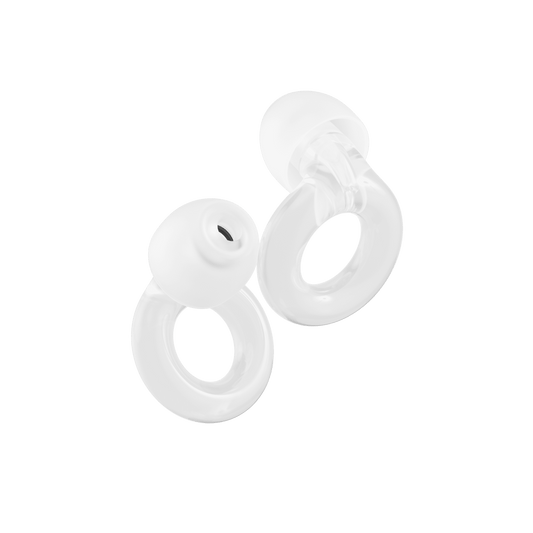Struggling to get a good night’s sleep? Noise might be the key to unlocking better rest. Both brown and pink noise can enhance your sleep environment by masking distractions and promoting relaxation. But what are they? And what is brown noise vs white noise vs pink noise? Let’s take a look at the differences.
Introduction to noise types for sleep
If you struggle to sleep at night in noisy environments, using sound can sometimes help – although it might sound counterintuitive. While white noise is often the go-to option, other noise frequencies like brown and pink noise are preferred by some.
Unlike white noise, which maintains a consistent intensity across all frequencies, pink and brown noise emphasize lower frequencies, which creates a deeper, richer sound. These sounds can help you to fall asleep faster, and stay asleep for longer, helping you to enjoy a more restful sleep. So, if you want to find out whether pink or brown noise for sleep might be beneficial for you, let’s dive into more of the details.
What is pink noise?
Pink noise is a combination of different noises from across the sound spectrum, containing all frequencies between 20 Hz and 20,000 Hz. It reduces the power of sounds at higher frequencies, and increases the power of sounds at lower frequencies to create a more even sound. So, what does pink noise sound like? It could be compared to steady rainfall, the lapping of waves on a beach, or water trickling down a waterfall.
These sounds can be particularly effective for promoting relaxation, encouraging deeper, more restorative sleep cycles by creating a calming, auditory backdrop that eases the mind into a more relaxed state.
A small 2017 study looked at whether pink noise helped memory and recall in older adults.The study involved 13 adults aged 60 and older, who took a memory test in the evening before bed two consecutive nights. On both nights, they went to sleep wearing an electrode cap and headphones, and upon waking they repeated the memory test. One night, they listened to pink noise while they slept, and no sound was played on the other night.
It was found that the participants performed three times better in the memory task after listening to pink noise throughout the night compared to their previous night’s test, while the test results didn’t improve as much on the night they didn’t listen to anything. That suggests that, when listened to at the right time, pink noise could be a good aid for study and work.
Research from 2020 backed up these findings. Participants were exposed to different types of noise: red, pink and white, as well as a quiet environment. While being exposed to each type of noise, the participants were tested on their:
- psychomotor speed (speed of thinking and the speed of movement related to cognitive function)
- continuous performance (sustained and selective attention)
- executive function (the ability to plan ahead and set goals)
- working memory
For all three colors of noise, participants performed much better on the psychomotor speed test compared to the quiet environment, while pink noise gave the only significantly positive result for the continuous performance test. All of the colors showed improvement compared to the quiet environment when it came to working memory – although white noise showed the most improvement. Finally, red and pink noise increased the participants’ ability to make good judgements.
So, it sounds like pink noise is a great choice for improved focus, memory and decision-making. Like white noise, it can also help you to drift off to sleep faster.
What is brown noise?
Brown noise is a low-frequency sound that offers a deeper, fuller auditory experience compared to both white and pink noise. Its emphasis on the lowest frequencies creates a rich, rumbling sound that feels more grounding and steady. For some people, white noise can be harsh or distracting, due to the high frequency sounds. But those frequencies are removed from brown noise, creating a sound that’s more pleasant to listen to.
Brown noise is much deeper than white or pink noise, which could be compared to a heavy rainfall, rumbling thunder, the sound of ocean waves or a strong power shower.
There’s not as much research into how brown noise affects sleep. There are some studies that indicate that slow, repetitive rhythms in music can provide a sense of safety and familiarity, which may help to stimulate the brain’s sleep response. Brown noise may provide a similar effect on the brain, helping you to drift off to sleep – but more research is needed to prove this conclusively.
Featured collection
-
Experience 2 Plus
VentePrix habituel €39.95Prix habituelPrix unitaire par
Benefits of brown and pink noise for sleep
Like white noise, brown and pink noise are both popular tools for helping people to improve their sleep quality. While research may be limited in this area, there’s plenty of anecdotal evidence to support this. Both pink and brown noise can help to mask disruptive background noises like traffic and snoring, which helps to create a quieter environment for uninterrupted sleep.
Pink noise has gentle balanced tones, which may mean that you have a deeper sleep. Brown noise, on the other hand, is a deeper and heavier type of sound. It may be particularly effective for those with noise sensitivities as it offers a steady, calming backdrop that blocks out loud noises from outside.
Whether you struggle to fall asleep, find yourself waking up during the night because of noise from inside or outside your home, or simply want to enhance relaxation, both brown and pink noise can offer valuable benefits for a better night’s sleep.
Earplugs as an alternative or complement to sound solutions
If you don’t like the idea of using brown or pink noise, or you want even more sound reduction, earplugs for sleeping are a great solution to give you even more control over noise levels in your bedroom. This dual approach means you can reduce noise levels to suit your needs, blending the calming effects of brown or pink noise with the noise-blocking benefits of earplugs for an even better night’s sleep.
Loop Dream™ earplugs are specially designed for sleep, offering our most powerful noise reduction of 27 dB (SNR) to reduce the noises that keep you awake at night. Every feature is specifically designed to maximize sleep comfort. They’re made from our softest silicone, with an innovative earplug body that reduces pressure on the ear – even if you sleep on your side. They also come with new hybrid memory foam-silicone ear tips that follow the natural shape of your ears for added comfort.
You may even find that you can fall asleep simply using Loop Dream earplugs and you don’t need to use brown or pink noise after all – but it’s a good idea to experiment and see what works best for you.
Enhancing your sleep environment with the right noise
Brown and pink noise can both offer powerful benefits for improving sleep quality, from masking noisy distractions to promoting deeper relaxation. That can help to create a better environment for restorative rest, especially for those who are noise sensitive.
For added flexibility, consider pairing Loop Dream earplugs with brown or white noise to reduce noise levels by 27 dB (SNR). Whether used alone or in combination with brown or pink noise, they can provide the control you need to tailor your sleep environment for your dreamiest sleep ever.












